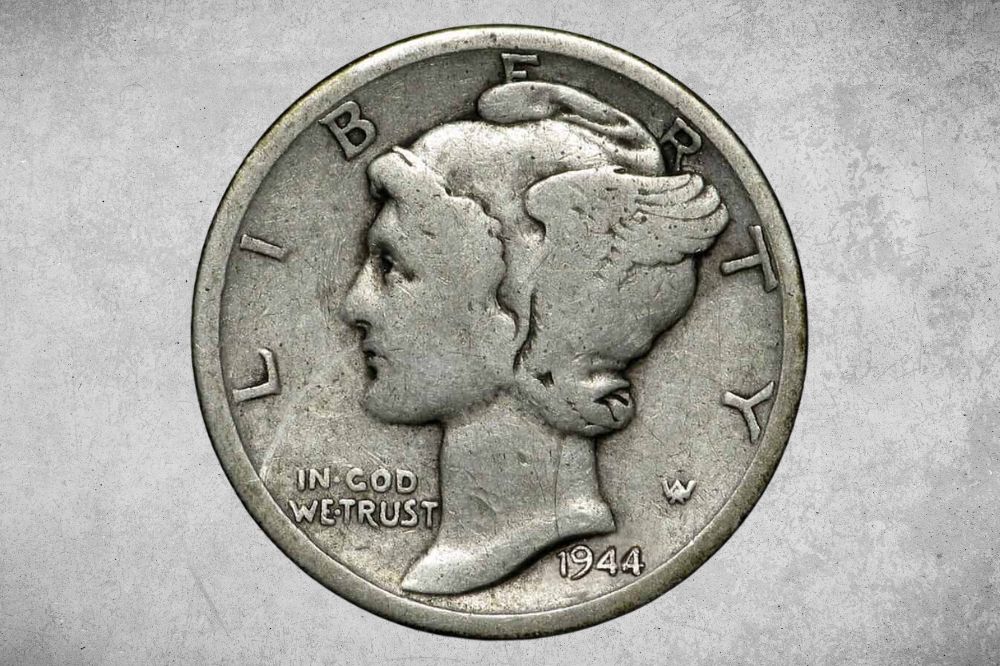Many coin collectors and historians see the 1944 mercury dime as the most elegant coin design of the century. The striking portrait of Lady Liberty wearing a winged Phrygian cap and its silver composition makes the coin a lovely addition to any coin collection.
Here’s a detailed overview of the 1944 dime value, its varieties, rare errors to look for, and the relevant questions to make your search for the 1944 dime more productive.
1944 Dime Details
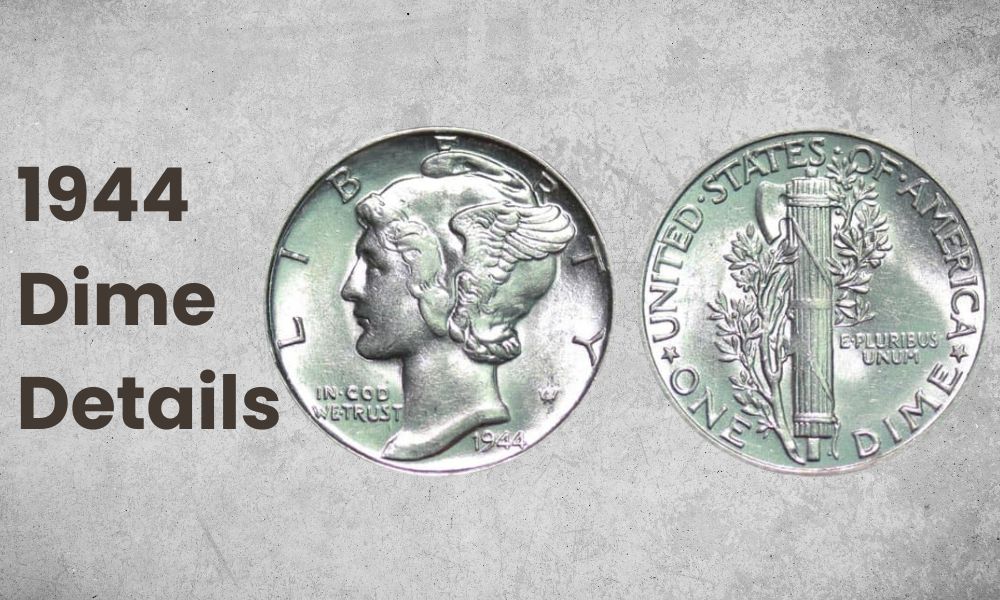
Although the dime is smaller than the nickel, it’s double the face value. These coins are traded within the affordable price range, selling for a few dollars. However, pieces in untouched condition are always valued higher. The value is also influenced by the mint they were produced in and whether the coins have any errors.
- Weight: 2.5 grams
- Reverse Designer: Adolph A. Weinman
- Category: Mercury dimes (1915 to 1945)
- Mint: Philadelphia, San Francisco, Denver
- Mintage: 340,000,000
- Obverse Designer: Adolph A. Weinman
- Fineness: 0.9
Obverse Design
The front side of the coin depicts the portrait of Lady Liberty facing to the left. While previous portraits of Lady Liberty used in earlier coins were seen as wearing a pointed crown, this portrait of the Lady had a winged cap, making many people mistake the portrait to be of Hermes or Mercury. This confusion led to the coin getting the nickname 1944 mercury dime.
Conversely, the official name of the coin is the winged liberty head dime. You’ll see the words In God We Trust below the Lady’s chin, whereas the date struck below the portrait’s neckline. Liberty is also written in block letters, covering over half of the coin’s upper rim. The designer’s initials are also engraved near the coin’s lower right rim.
Reverse Design
On the tail side, you’ll see an olive tree branch wrapping around the fasces, a Roman symbol of power and authority. The fasces is represented as a bundle of firewood attached to an axe.
On the 1944 dime, the fasces represents the country’s peace policy and an indication that the nation was ready to face any hard time during the war. Along the coin’s rim, you’ll see several words and phrases.
On the upper rim of the coin, you’ll see the United States of America with dots between the words, whereas on the bottom rim, the words One Dime is struck with two stars separating the texts. You’ll see the mint mark beside the word One, directly below the olive branch. The phrase E Pluribus Unum is also struck to the right side of the coin surface.
1944 Dime Value Chart |
|||||
| Mint Mark | Good | Fine | Extremely Fine | Uncirculated | Mint |
| 1944 no mint mark dime | $2.02 | $3.13 | $3.4 | $6.2 | $28 |
| 1944 D dime | $2.02 | $3.1 | $3.4 | $7.13 | $35 |
| 1944 S dime | $2.02 | $3.1 | $3.4 | $7.3 | $35 |
1944 Dime Value and Varieties Guides
The 1944 dime is regarded as the thinnest circulating coin which is smaller in size than the nickel but has more face value. The reason for making a thin and small coin at the time was to keep the face value of the coin below the added silver.
While other coins had several changes in their composition, the dime’s composition didn’t change. While the dime starts from a few dollars, higher-graded coins or full-band coins are the most valuable. Here are the different dime varieties to let you better determine their value.
1944 Dime No Mint Mark Value
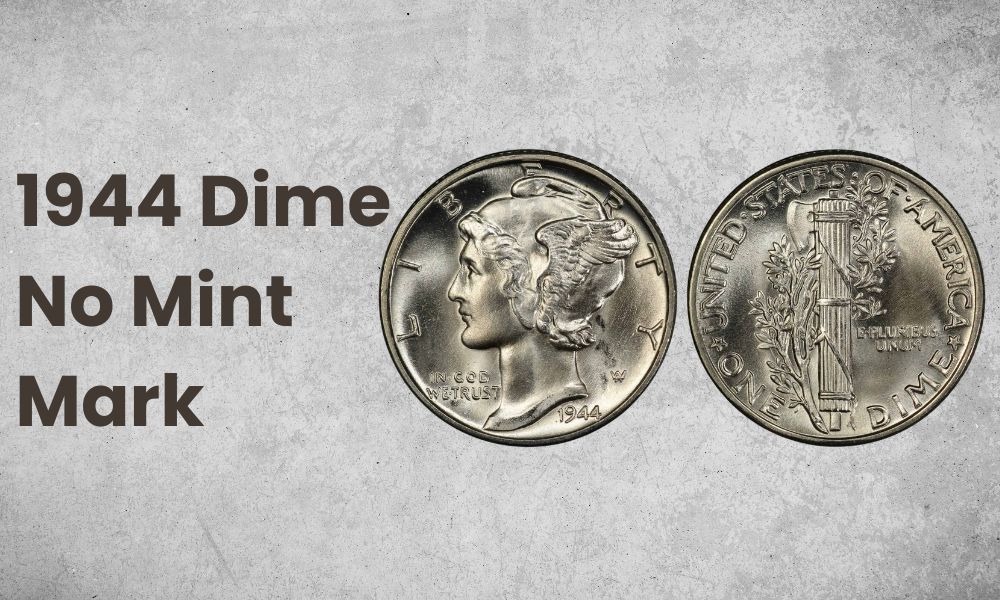
- Place of Minting: Philadelphia
- Face Value: $0.1
- Mass: 2.5 grams
- Edge: Reeded
- Mint Mark: No mint mark
- Year of Minting: 1944
- Diameter: 17.9 mm
- Type: Mercury dime
- Price: $2 to $34
- Quantity: 231,410,000
The Philadelphia mint produced 231,410,000 silver dimes in 1944 . The mint didn’t place any mint marks on the coin, and it was meant for circulation. While the good condition 1944 dime will only cost you $3 to $5, coins in untouched condition are the most valuable.
An MS-68 dime with all the features can cost around $15,000. The most noticeable feature of coins in mint condition is the presence of visible rope bands on the fasces. To be exact, the naked eye can still see three rope bands with minor detailing. While the top of the fasces has three sets of ropes, the two bands in the middle and bottom have two bundle straps each.
1944 D Dime Value
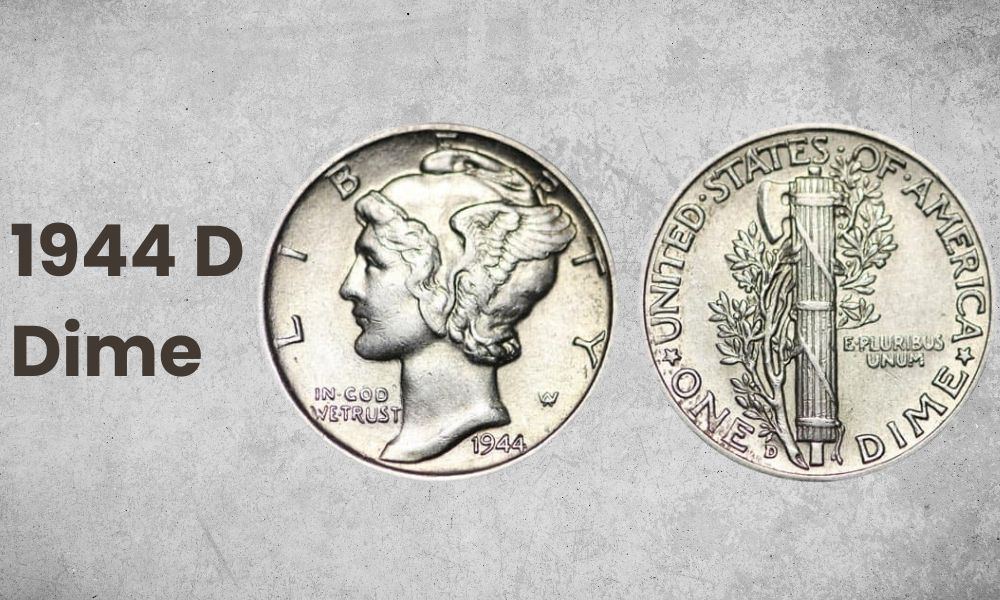
- Price: $3 to $35
- Quantity: 62,224,000
- Mint Mark: D
- Diameter: 17.9 mm
- Edge: Reeded
- Place of Minting: Denver
- Face Value: $0.1
- Type: Mercury dime
- Year of Minting: 1944
- Mass: 2.5 grams
62,224,000 coins were minted in the Denver mint, which included the D mint mark. You can find a fine condition coin sold for $ 4 to $5, whereas a mint condition coin costs $55 to $65. These coins are similar in value to the no-mint mark variety, but the coin’s higher-graded varieties sell for more. An MS 68+ coin with full bands can easily sell for over $3200. A similarly graded dime was sold in an auction in 2019 for $5040.
1944 S Dime Value
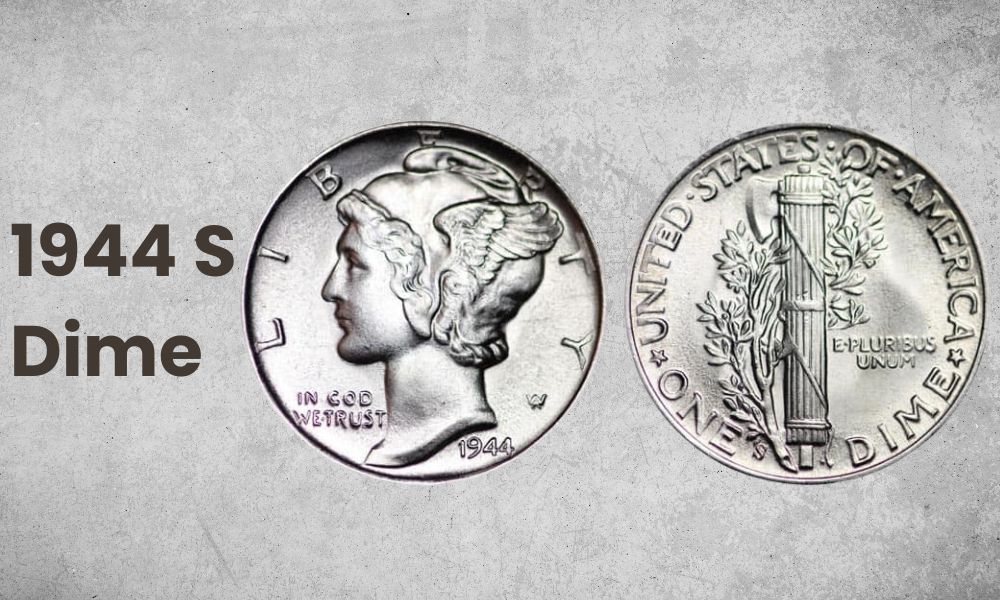
- Year of Minting: 1944
- Place of Minting: San Francisco
- Mint Mark: S
- Face Value: $0.1
- Diameter: 17.9 mm
- Price: $3 to $34
- Type: Mercury dime
- Edge: Reeded
- Quantity: 49,490,000
- Mass: 2.5 grams
Around 49,490,000 coins were minted in 1944 and can be bought for a starting price of a few dollars, depending on the dime’s condition. However, the rare and expensive pieces are costly and can sell for thousands of dollars. Even in their poorest condition, the dimes are still worth the melt value of silver they contain.
Also Read: Top 15 Most Valuable Indian Head Penny Worth Money
1944 Dime History
Before we read the history of the 1944 dime, let’s read where the word dime originated. We use the word dime today in the French word Disme which means a ninth or a tenth. The first-ever American dimes were introduced in 1792 and had one-tenth the value of a silver dollar. The weight of the dime to the silver dollar was also kept to a ratio of 1:10.
Until the start of the first World War, most coins circulated within America were either gold or silver. However, difficult economic conditions, price fluctuations, and wars led people to stack these coins and sell the molten silver or gold for a higher value. The U.S. treasury tackled this issue of stacking and selling metal by introducing cheaper metals like copper, nickel, zinc, and steel.
The dime we use today is a mix of copper and zinc, but back in 1944, the dime was still made of 90% silver and 10% copper. The dime was minted from 1916 until 1945 when the composition and design of the dime were changed. The 1944 edition of the dime was the second last year of the design, after which it was changed to the Roosevelt dime that we use today.
Initially, the coin was designed by engravers officially hired by the mint. Charles Barber crafted the barber dime design, but during the start of 1904, the mint hired professional artists on the recommendation of the 26th president of the USA, Theodore Roosevelt.
The president wanted the coins to be symbolic, convey a message, and look artistic. Therefore, he insisted on hiring a renowned artist, Augustus Saint-Gaudens. He came up with the initial designs of many coins but was suffering from a terminal illness that led to his demise. His work was carried on by his assistants, including Earle Fraser, who designed the buffalo nickel, and the sculptor of the Lincoln penny, Victor D. Brenner.
Surprisingly, the work on the 1944 mercury dime was done by one of Saint Gaudens’ students named Adolph A. Weinman. He competed in the dime designing competition and was declared a winner against three other sculptors. While most people assumed the portrait to be linked to Hermes, aka Mercury, the portrait was inspired by a female named Elsie Kachel Stevens. She was the wife of the poet and insurance lawyer Wallace Stevens.
The couple lived in a rented apartment owned by Weinmann, which inspired Weinmann to take her as the model for Lady Liberty. The Lady’s portrait on the coin is wearing a winged Phrygian cap which most people confuse with the headgear similar to the Roman Gods.
These winged caps symbolized freedom and were historically worn by slaves during the American and French revolutions.
Also Read: Top 15 Most Valuable Roosevelt Dimes Worth Money
1944 Dime Grading
The value of the 1944 dime depends on the coin’s condition. You’ll find several grades of 1944 dimes, from $3.3 for a good-condition coin to up to $80 for an uncirculated piece in mint condition. Here’s a video to better aid you in grading 1944 dimes.
1944 Dime Errors
While excellent quality coins are always a good find for coin collectors, the low-quality ones are sought after by silver stackers to keep low-grade coins as junk silver, an affordable way to stack up on the metal. However, the dimes with certain errors are always the most valuable. Let’s read what errors you can possibly find in 1944 dimes.
1. 1944 Dime Uncentered Broadstrike Error
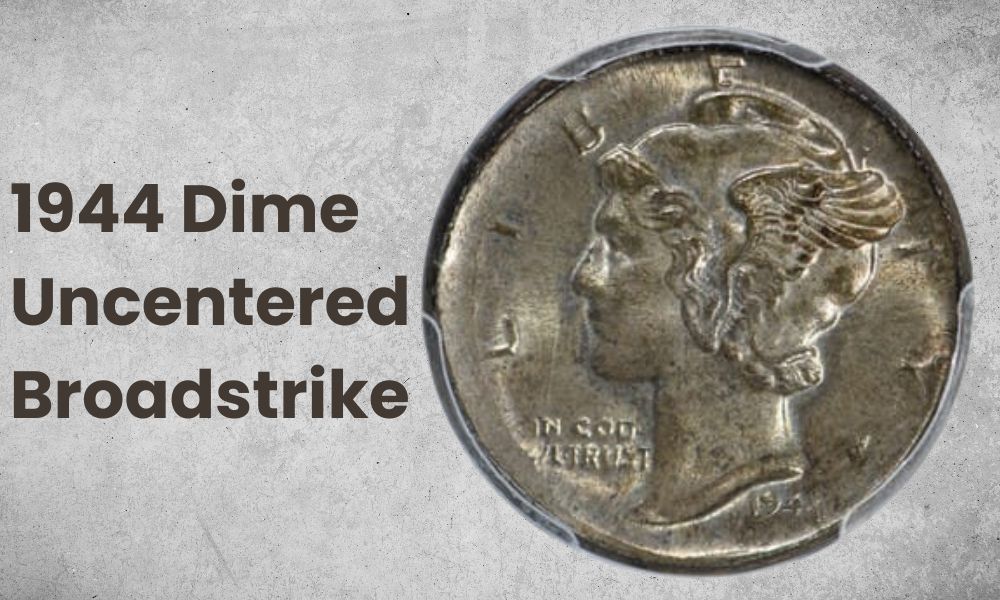
During the coin minting, at least three collars are placed around to maintain the coin shape when the die strikes the coin surface. The coin can bleed outside the borders, if the collars are not in place, resulting in a thinner and wider dime. The coins minted without collars have a broad strike error, and even low-grade dimes with this error sell for $175.
2. 1944 Dime D/D RPM Error
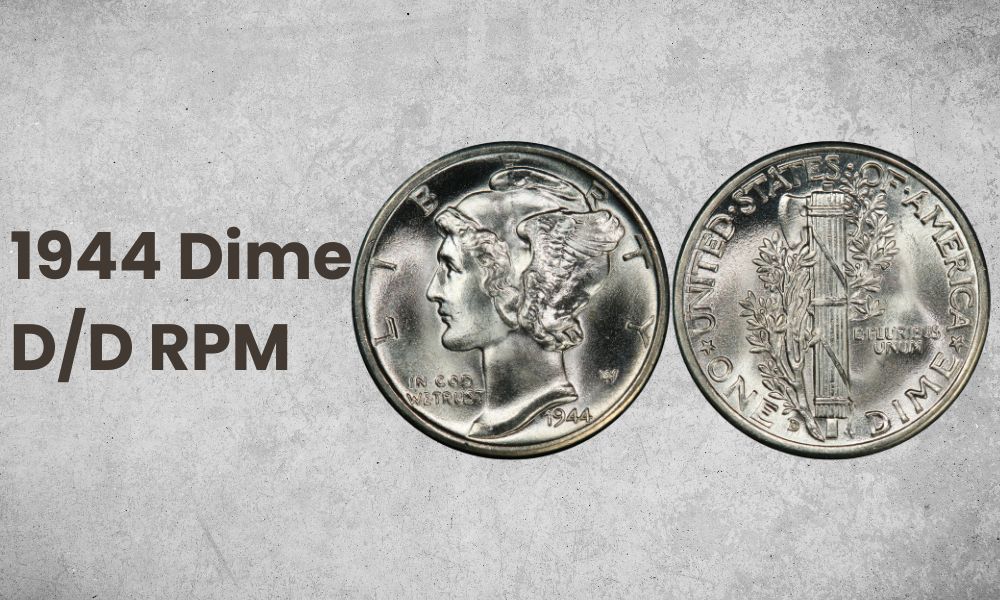
The RPM error occurs when the coin’s planchet moves during the mint mark punching process, leaving behind a double or triple mint mark. The re-punched mint mark in extremely fine condition can cost you $125.
3. 1944 Dime DDO Error
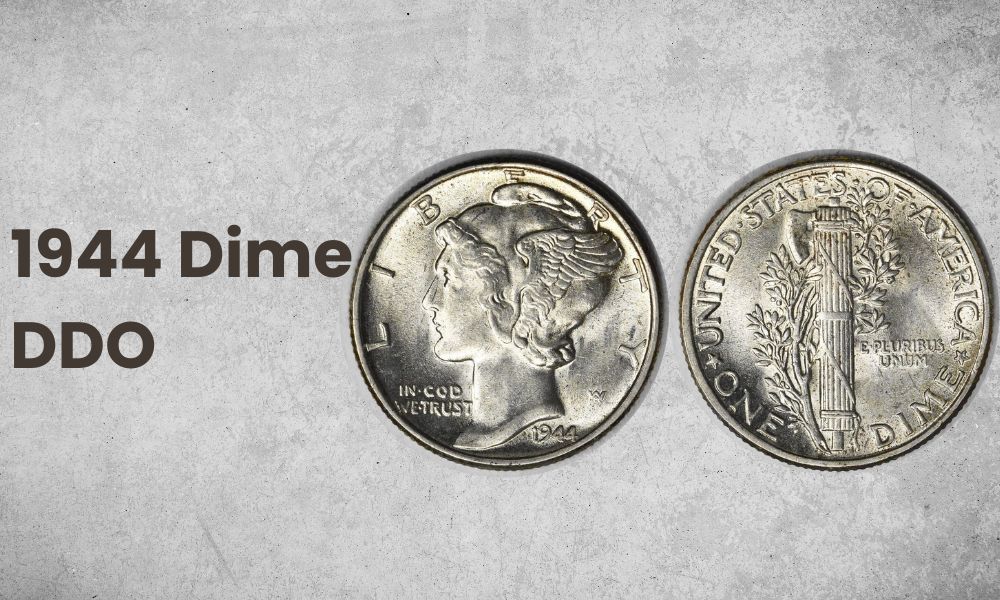
The double die error on the 1944 dime is hard to identify as the font used for the dime has rounded edges. However, placing a double-die coin and a regular coin can make the difference evident. You’ll see a puffy ballooning effect on the letters. These dimes range between $50 and $200.
4. 1944 Dime T-I Broadstruck Error
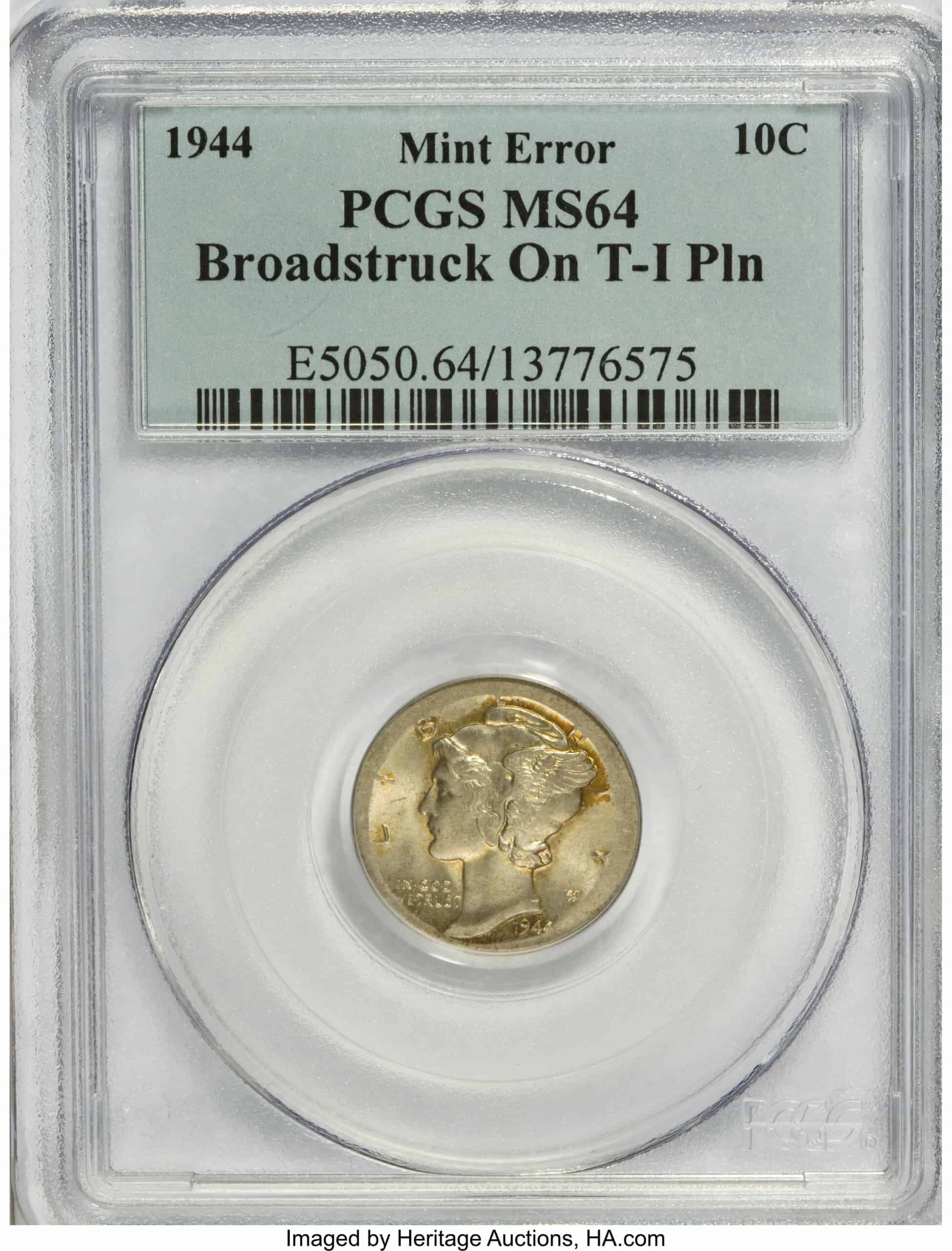
This error is among the rarest and most valuable. A fine-grade dime with the T-I broadstruck is sold for more than $100. You’ll see a flattening of the coin on both sides of the coin due to missing collars, making these pieces cost over $350.
5. 1944 Dime Ragged Clip Planchet Error
Bent or jagged planchet results in the Ragged clip planchet error where the dime appears squashed inwards. This coin error increases the value of the coin to around $125.
6. 1944 Dime Clipped Planchet Error
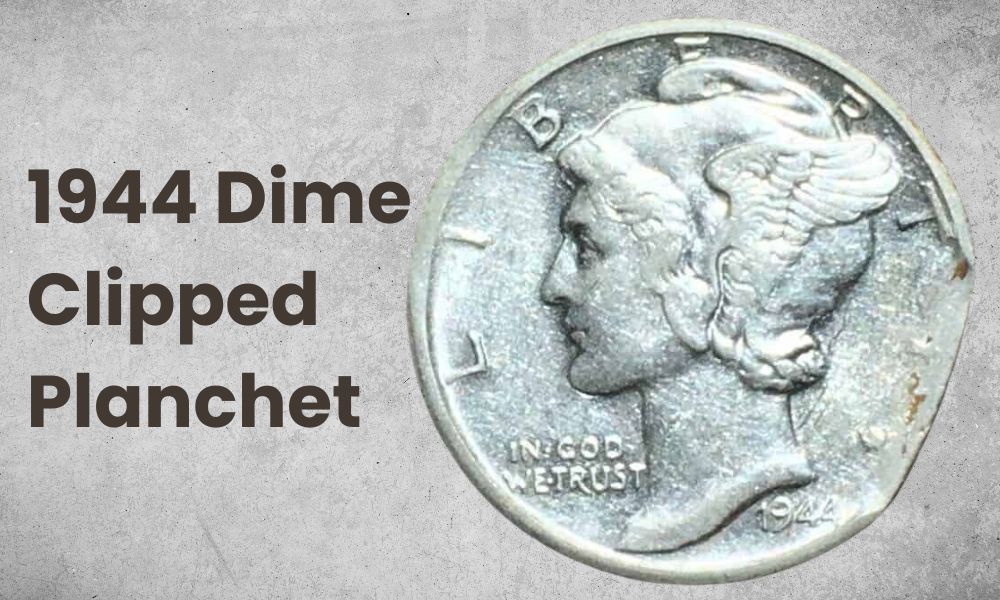
Planchets are normally made by punching them from a metal sheet and passing them through the coin hopper. A clipped planchet was a rare error when they punched a misaligned coin blade or a previous coin cut a blank disk. The coin’s clipped-off percentage determines the value of the coin. A 1944 mercury dime clipped 12% in good condition has a value of $50 to $60.
7. 1944 Dime Struck 30% Off Center Error
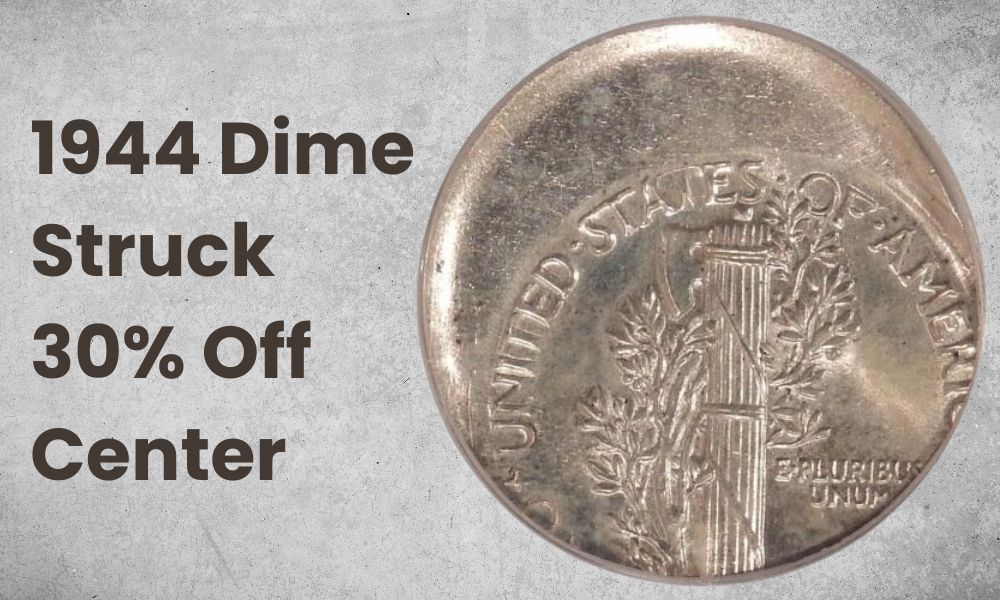
During the die strike, the imprint will be off-center if the planchet moves from its original position. Poor assembly of the die can also result in this error. The more the coin is struck off-center, the more value it has. Uncirculated 1944 dimes in mint condition with this off-center error are sold for $1100 and upwards.
8. 1944 Dime Obverse Struck Through Scrap Error
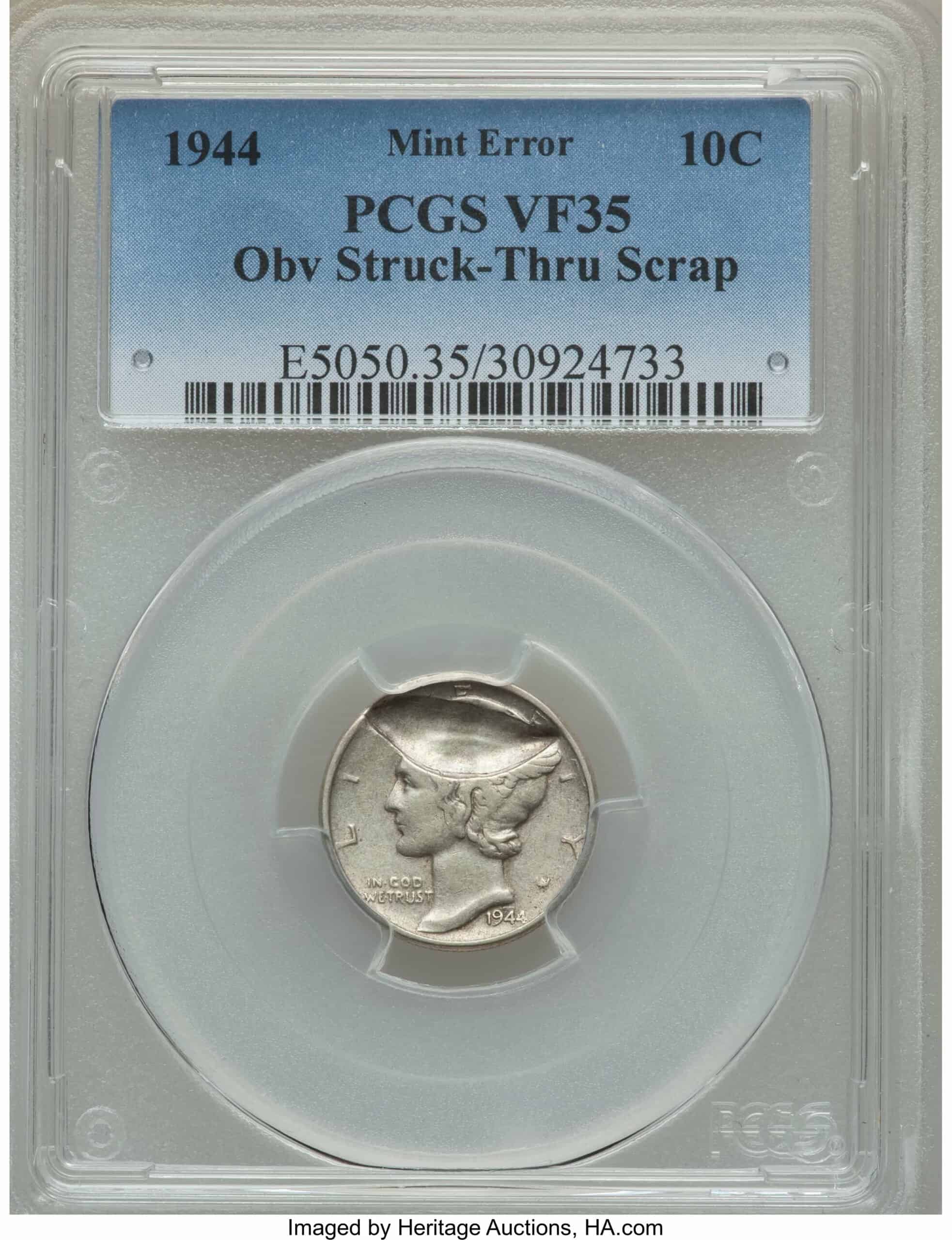
During the dime minting process, if any foreign object comes between the coin surface and the die, the foreign substance will leave a flaky impression on the coin’s surface. Coins with this error are worth $100.
9. 1944 Dime Double Struck Flip Over Error
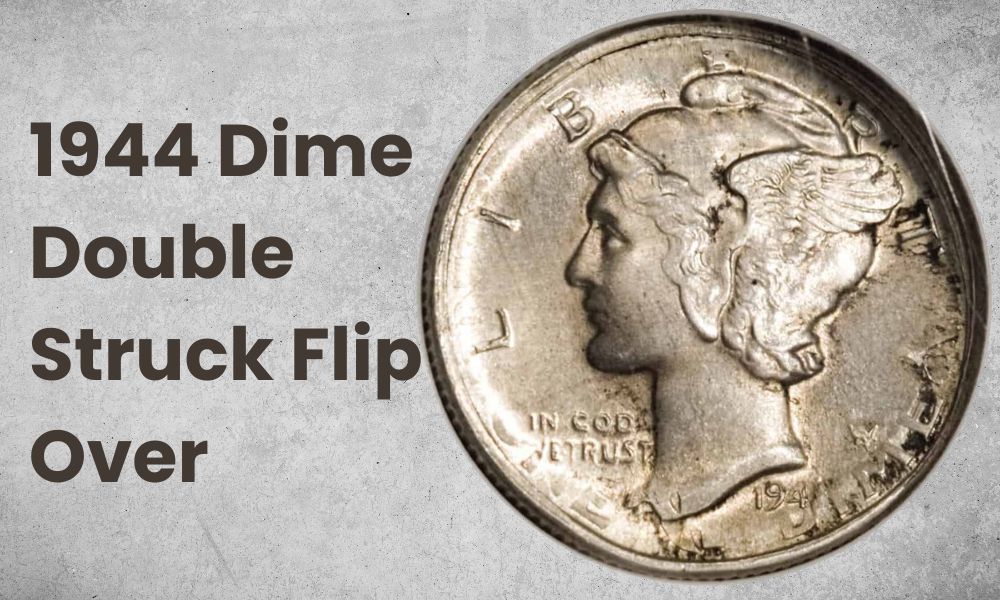
Typically, coins are struck twice to make detailed outlines and sharp images. However, if the coin gets flipped before the second strike, it can result in this error. You might see details of the reverse side on the obverse side and vice versa. These rare finds are more than $3500, and higher qualities sell for even more.
1944 Dime FAQs
How rare is the 1944 mercury dime?
340 million dimes were minted in 1944, making these coins a common find for coin collectors. However, the 1944 dimes with the double struck flip over, and the off-center error can sell for thousands of dollars, depending on their condition.
Which dime is the most valuable?
The 1803 dime is the most valuable dime minted in US history. Thirty-three thousand forty dimes were minted during the time and are difficult to find. The 1803 draped bust dime 2008 was sold to a collector for $322,000.
Which mercury dime is rare?
Although the dime was minted for many years, the following coins are rare to find. These include the 1921 dime, 1916-D dime, 1926 S mercury dime, 1931 D mercury dime, and the 1942 over 41 varieties.
